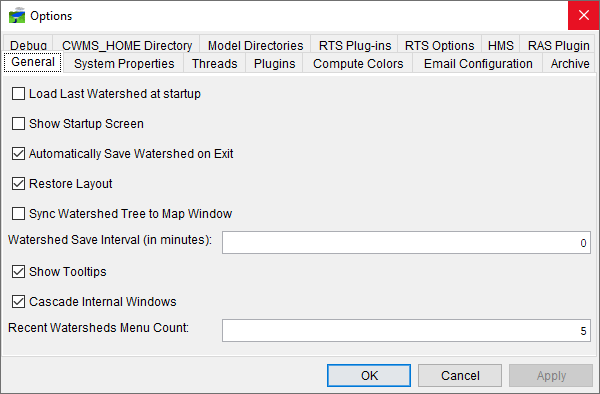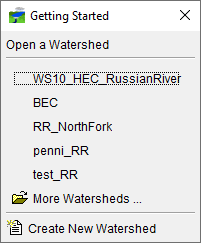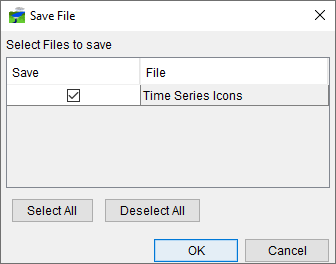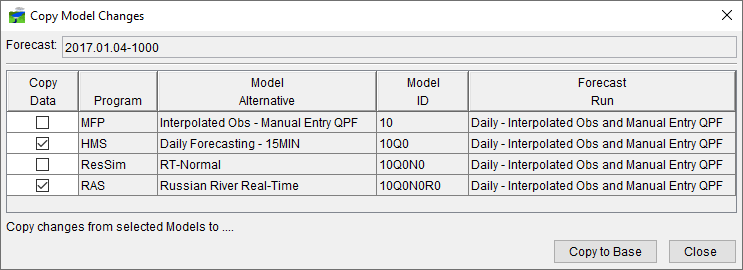General Tab
From the Options dialog, from the General tab (Figure 1), the user can set the last study to be loaded during the startup of HEC-RTS; display a dialog box that allows the user to open or create a study; save the study automatically when exiting HEC-RTS; restore the default layout; synchronize the Study Tree to the active Map Window; set an interval (minutes) for automatically saving a study; display tooltips; set default scheme for cascading windows; and, specify the number of HEC-RTS watersheds to display in the Recent Studies item under the File menu.

Load Last Watershed at Startup
HEC-RTS by default does not automatically load the last watershed that has been opened. If you want the last watershed you opened to automatically load when HEC-RTS startups, from the Options dialog, from the General tab (Figure 1), click Load Last Watershed at startup. The next time you re-start HEC-RTS, the last watershed that was open will automatically load.
Show Startup Screen
HEC-RTS by default does not automatically display the Getting Started dialog (Figure 2) on startup. The Getting Started dialog, provides you with a list of the last five HEC-RTS watersheds that were open; more watersheds can be accessed from the Open Watershed dialog (Opening an Existing Watershed); and, create new watersheds (Creating a Watershed).

To open a recent watershed, click on a watershed name, the Getting Started dialog will close, and the watershed will display in the HEC-RTS main window. To access watersheds not listed, click More Watersheds (Figure 2), the Open Watershed dialog will display (Opening an Existing Watershed). Select a watershed, the Open Watershed dialog will close, the watershed will display in the HEC-RTS main window, and the Getting Started dialog will close.
From the Getting Started dialog, you can create a new watershed, click Create New Watershed (Figure 2), the Create New Watershed dialog will open (details for creating a watershed are detailed in Creating a Watershed). Click OK, the Create New Watershed dialog will close, the new watershed will display in the HEC-RTS main window, and the Getting Started dialog will close.
If you want the Getting Started dialog (Figure 2) displayed when starting HEC-RTS, from the Options dialog, from the General tab (Figure 1), click Show Startup Screen. The next time you re-start HEC-RTS, the Getting Started dialog will display.
Automatically Save Watershed on Exit
HEC-RTS by default automatically saves the open watershed on exit. If you do not want HEC-RTS to save the current watershed on exit, from the Options dialog, from the General tab (Figure 1), un-select Automatically Save Watershed on Exit.
For example, when making changes to the watershed, you change the name of a time series icon, and you make change to two of the model alternatives. When closing this watershed, the Save File dialog will open (Figure 3) letting you know that there is a change to the time series icons layer - do you want to save that change. The Copy Model Changes dialog will open (Figure 4) because of the changes you made to model alternatives that are part of the watershed – do you want to save those changes.


Restore Layout
The capability in HEC-RTS to restore layouts is on by default, which means that information about the current layout of the map windows is automatically saved when exiting HEC-RTS. Layouts can be saved, managed, and restored. From the Options dialog, from the General tab (Figure 1), if you do not want the capability to restore layouts, un-select Restore Layout.
Sync Watershed Tree to Map Window
By default, in HEC-RTS, the watershed tree of the current watershed is synchronized with the Map Window being currently displayed in the HEC-RTS main window. From the Options dialog, from the General tab (Figure 1), if do not want the study tree to be synchronized with the active Map Window, un-select Sync Study Tree to Map Window.
Watershed Save Interval
HEC-RTS by default automatically sets the interval for a watershed save to zero, which means that a watershed is not automatically being saved while the watershed is open. From the Options dialog, from the General tab (Figure 1), if you want to automatically save watersheds, from the Watershed Save Interval box, enter a time in minutes.
Show Tooltips
HEC-RTS by default automatically displays tooltips in the HEC-RTS interface. If you do not want to view tooltips, from the Options dialog, from the General tab (Figure 1), un-select Show Tooltips. Now as you hover over items in the HEC-RTS interface you will no longer see tooltips.
Cascade Internal Windows
HEC-RTS by default the capability to cascade map windows is set. If you do not want map windows to cascade, from the Options dialog, from the General tab (Figure 1), un-select Cascade Internal Windows.
Recent Watersheds Menu Count
HEC-RTS by default automatically displays the last five watersheds that have recently been opened. If you want to view more or less watersheds, from the Options dialog, from the General tab (Figure 1), from the Recent Watersheds Menu Count box (Figure 1), enter a new value. The value must be 1 from 10. Any value entered that is less than the value in the Recent Watersheds Menu Count box (Figure 1), purges the list of recent watersheds. An upper limit of 10 is a recommendation, you can enter a large value, but be aware that the longer the list, how that might impact Recent Watersheds list.